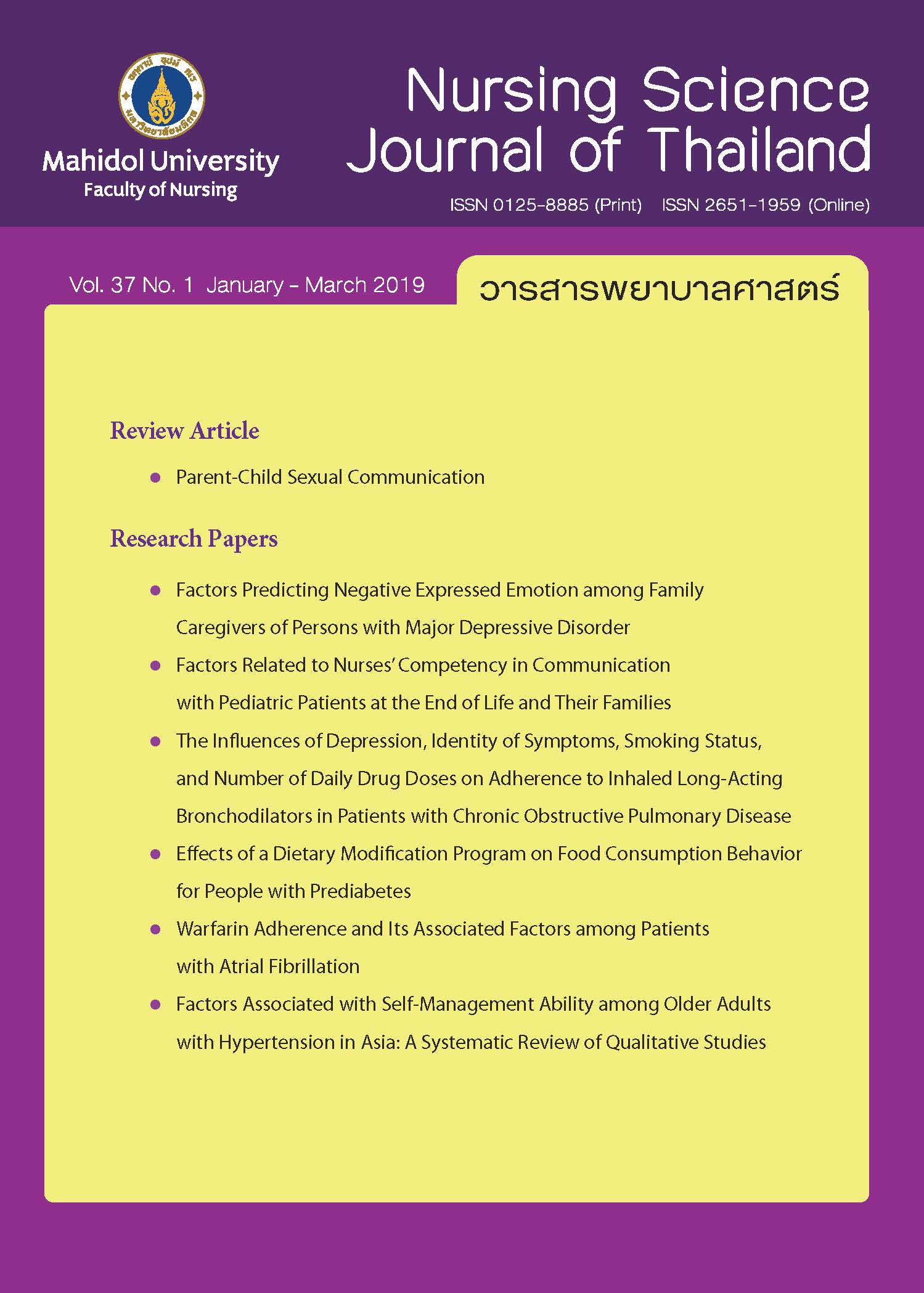Warfarin Adherence and Its Associated Factors among Patients with Atrial Fibrillation
Main Article Content
Abstract
Purpose: To identify level of warfarin adherence and investigate factors associated with warfarin adherence in Thai patients with atrial fibrillation.
Design: Correlational predictive study.
Methods: This study was conducted at a university hospital in Thailand. One-hundred twenty patients with non-valvular atrial fibrillation receiving warfarin were recruited. Data were collected using Thai versions of Anticoagulation Measurement of Treatment Adherence Scale, Medication Regimen Complexity Index, Health Literacy Scale, and Beliefs about Oral Anticoagulation Survey. Descriptive statistics, Spearman’s correlation, and multiple linear regression analysis were applied to analyze the data.
Main Findings: The findings indicated that all participants in this study had high warfarin adherence ( = 5.76, SD = .25). However, only 45.8% of them could maintain International Normalized Ratio (INR) within the therapeutic range. The complexity of a warfarin regimen, health literacy, perceived benefits and perceived barriers of taking warfarin jointly predicted 14% of the variance in warfarin adherence (R2 = .140, F(4,115) = 4.664, p = .002). Participants with lower perceived barriers had better warfarin adherence (β = -.285, p = .002).
Conclusion and recommendations: Although all participants in this study adhered to warfarin, they still had risks of INR instability. Health care providers should pay more attention to decreasing barriers of taking warfarin to enhance warfarin adherence and maintaining INR within the target range.
Article Details
Copyright Notice: Nursing Science Journal of Thailand has exclusive rights to publish and distribute the manuscript and all contents therein. Without the journal’s permission, the dissemination of the manuscript in another journal or online, and the reproduction of the manuscript for non-educational purpose are prohibited.

Disclaimer: The opinion expressed and figures provided in this journal, NSJT, are the sole responsibility of the authors. The editorial board bears no responsibility in this regard.
References
2. Camm AJ, Lip GY, De Caterina R, Savelieva I, Atar D, Hohnloser SH, et al. 2012 focused update of the ESC guidelines for the management of atrial fibrillation: an update of the 2010 ESC guidelines for the management of atrial fibrillation developed with the special contribution of the European Heart Rhythm Association. Eur Heart J. 2012;33(21):2719-47.
3. Wigle P, Hein B, Bloomfield HE, Tubb M, Doherty M. Updated guidelines on outpatient anticoagulation. Am Fam Physician. 2013;87(8):556-66.
4. Garkina SV, Vavilova TV, Lebedev DS, Mikhaylov EN. Compliance and adherence to oral anticoagulation therapy in elderly patients with atrial fibrillation in the era of direct oral anticoagulants. J Geriatr Cardiol. 2016;13(9):807-10.
5. Suzuki T, Shiga T, Omori H, Tatsumi F, Nishimura K, Hagiwara N. Adherence to medication and characteristics of Japanese patients with non-valvular atrial fibrillation. J Cardiol. 2017;70(3):238-43.
6. Balkhi B, Al-Rasheedi M, Elbur AI, Alghamadi A. Association between satisfaction with and adherence to warfarin therapy on the control of international normalized ratio: a hospital-based study in Saudi Arabia. Saudi Pharm J. 2018;26(1):145-9.
7. Kalatad T, Ua-Kit N. Selected factors related to anti-coagulant medication adherence in valvular replacement patients. Thai Journal of Cardio-Thoracic Nursing. 2010;22(2):2-14. (in Thai).
8. World Health Organization. Adherence to long-term therapies: evidence for action. Geneva, Switzerland: World Health Organization; 2003.
9. Aronis KN, Edgar B, Lin W, Martins MAP, Paasche-Orlow MK, Magnani JW. Health literacy and atrial fibrillation: relevance and future directions for patient-centred care. Eur Cardiol. 2017;12(1):52-7.
10. Zhang NJ, Terry A, McHorney CA. Impact of health literacy on medication adherence: a systematic review and meta-analysis. Ann Pharmacother. 2014;48(6):741-51.
11. Orensky IA, Holdford DA. Predictors of noncompliance with warfarin therapy in an outpatient anticoagulation clinic. Pharmacotherapy. 2005;25(12):1801-8.
12. Tepsuriyanont S, Jirapaet V, Luangmomlert S, Praditsuwan R. Relationship between regimen complexity and medication adherence behavior in Thai elderly with hypertension. Chulalongkorn Medical Journal. 2011;55(5):457-72. (in Thai).
13. Kumkrong C, Maneesriwongul W, Janpanich P. Relationships of health literacy and knowledge about antiretroviral therapy to medication adherence among people living with HIV. Kuakarun Journal of Nursing. 2014;21(2):211-28. (in Thai).
14. Institute of Geriatric Medicine, Department of Medical Service, Ministry of Public Health. Mini-mental state examination Thai version. Nonthaburi: Institute of Geriatric Medicine; 2002. (in Thai).
15. Faul F, Erdfelder E, Buchner A, Lang AG. Statistical power analyses using G*Power 3.1: tests for correlation and regression analyses. Behav Res Methods. 2009;41(4):1149-60.
16. George J, Phun YT, Bailey MJ, Kong DC, Stewart K. Development and validation of the medication regimen complexity index. Ann Pharmacother. 2004;38(9):1369-76.
17. Ishikawa H, Takeuchi T, Yano E. Measuring functional, communicative, and critical health literacy among diabetic patients. Diabetes Care. 2008;31(5):874-9.
18. Bennett SJ, Perkins SM, Lane KA, Forthofer MA, Brater DC, Murray MD. Reliability and validity of the compliance belief scales among patients with heart failure. Heart Lung. 2001;30(3):177-85.
19. Da Silva Carvalho AR, Dantas RA, Pelegrino FM, Corbi IS. Adaptation and validation of an oral anticoagulation measurement of treatment adherence instrument. Rev Lat Am Enfermagem. 2010;18(3):301-8.
20. Han WP, Hong SA, Tiraphat S. Factors related to medication adherence among essential hypertensive patients in tertiary hospitals in Yangon, Myanmar. Journal of Public Health and Development. 2015;13(2):57-70.


